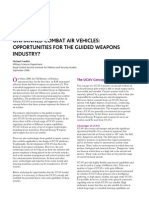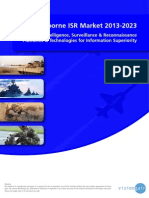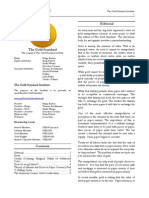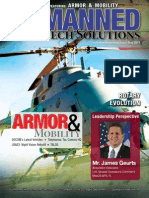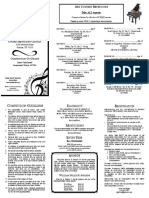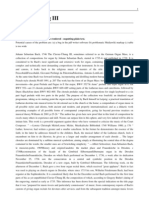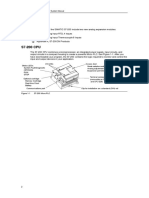Advanced UAV Surveillance Systems
Advanced UAV Surveillance Systems
Uploaded by
ulfheidner9103Copyright:
Available Formats
Advanced UAV Surveillance Systems
Advanced UAV Surveillance Systems
Uploaded by
ulfheidner9103Original Title
Copyright
Available Formats
Share this document
Did you find this document useful?
Is this content inappropriate?
Copyright:
Available Formats
Advanced UAV Surveillance Systems
Advanced UAV Surveillance Systems
Uploaded by
ulfheidner9103Copyright:
Available Formats
Advanced UAV
Surveillance Systems
SPECI AL REPORT
Looking South Towards World-Class UAVs Capability
The Growing Global Market for UAVs
The Power of Command of the Air in COIN
UAVs in Action: Lessons Learned
Future UAS
Sponsored by
Published by Global Business Media
SPECIAL REPORT: ADVANCED UAV SURVEILLANCE SYSTEMS
Published by Global Business Media
Global Business Media Limited
62 The Street Ashtead Surrey KT21 1AT
United Kingdom
Switchboard: +44 (0)1737 850 939
Fax: +44 (0)1737 851 952
Email: info@globalbusinessmedia.org
Website: www.globalbusinessmedia.org
Publisher
Kevin Bell
Business Development Director
Marie-Anne Brooks
Editor
Mary Dub
Senior Project Manager
Steve Banks
Advertising Executives
Michael McCarthy
Abigail Coombes
Production Manager
Paul Davies
For further information visit:
www.globalbusinessmedia.org
The opinions and views expressed in the
editorial content in this publication are those
of the authors alone and do not necessarily
represent the views of any organisation with
which they may be associated.
Material in advertisements and promotional
features may be considered to represent the
views of the advertisers and promoters. The
views and opinions expressed in this publication
do not necessarily express the views of the
Publishers or the Editor. While every care has
been taken in the preparation of this publication,
neither the Publishers nor the Editor are
responsible for such opinions and views or
for any inaccuracies in the articles.
2012. The entire contents of this publication
are protected by copyright. Full details are
available from the Publishers. All rights reserved.
No part of this publication may be reproduced,
stored in a retrieval system or transmitted in any
form or by any means, electronic, mechanical
photocopying, recording or otherwise, without
the prior permission of the copyright owner.
Contents
Foreword 2
Mary Dub, Editor
Looking South Towards World-Class UAVs Capability 3
By Denel Dynamics
The Best of Seeker II
Mounting Interest in Seeker 400
Skua Speed, Quality, Unmanned Agility
Small UAV Solution
Dynamic Evolution
About Denel Dynamics A Forward-Thinking Company
The Growing Global Market for UAVs 7
Marushka Dubova, Defence Correspondent
USAF (United States Air Force) Looking to All UAV Future
Extensive Civilian Applications for UAVs
UAVs for Counter Insurgency Operations
Persistence: a Key Feature of UAV Surveillance
Disadvantages of the Use of UAVs
UAVs for Nations Emerging from Conict
The Power of Command of the Air in COIN 9
Meredith LLewelyn, Lead Contributor
The Strategic Value of Air Power in Irregular Warfare
UAVs in Action: Lessons Learned 11
Don McBarnet, Staff Writer
The Importance of Speeding up Decision Taking
The Importance of Reection and Rules of Engagement in Decision Taking
Practical Limitations on the Use of UAVs
Future UAS 13
Marushka Dubova, Defence Correspondent
Bandwidth, Bandwidth, Bandwidth
Excess Global Use of UAS
References 14
WWW.DEFENCEINDUSTRYREPORTS.COM | 1
Advanced UAV
Surveillance Systems
SPECI AL REPORT
Looking South Towards World-Class UAVs Capability
The Growing Global Market for UAVs
The Power of Command of the Air in COIN
UAVs in Action: Lessons Learned
Future UAS
Sponsored by
Published by Global Business Media
Foreword
T
his Special Report focuses on the
new powerful and technologically fast
moving area of unmanned aerial vehicles
or systems. Every month new capabilities
are added to these increasingly ubiquitous
ying vehicles.
The Report opens with a piece that looks at the
design, development and manufacture of UAVs
in South Africa over the last 20 years, which place
South Africa at the forefront of UAV technology when
compared to many countries now entering the UAV
market. The article goes on to describe a number of
UAV systems, including the Seeker II and the Seeker
400 as well as the Skua system and outlines the
advantages of various systems for different roles
including asymmetric warfare, peace support and
homeland security, as well as the use of small UAVs
for civilian and other applications.
The second article looks at the growing global
market for UAS not only in the United States, but also in
niche specialist markets in Africa, the Middle East and
Asia. Despite or, perhaps, because of, defense budget
cuts, alternative and sometimes-cheaper methods of
delivering the benets of air power are being procured.
The rising demand for the wide spectrum of different
types of UAS currently appears resilient.
Counter Insurgency Operations (COIN) have found
frequent effective use for UAS. However their role is
frequently downplayed at the planning stage. The
third piece looks at the way that thinking by land
commanders is beginning to change as they place
increasing weight on the importance of UAS.
Lessons Learned from the eld are always vital.
The recent lessons generated by the use of UAVs
for surveillance, referred to in the fourth article, offer
useful guidance to manufacturers looking to improve
their products and to potential purchasers of UAVs
who seek a solution to problems that may generate
unintended consequences.
The final piece looks at the future for UAS
and concludes that their frequent and more
widespread use seems to be guaranteed.
However, there are many technological restraints
on their effectiveness that need to be lifted to
maximize their value to the full. Some of these
restraints are not in the UAVs themselves but
in problems created in the need to handle the
increased data ow and then for humans to take
well-judged decisions on the data generated. The
human factor will always be paramount and the
increased need for training for operators of UAVs
and the commanders who will take decisions on the
data generated will need further training.
Mary Dub
Editor
SPECIAL REPORT: ADVANCED UAV SURVEILLANCE SYSTEMS
2 | WWW.DEFENCEINDUSTRYREPORTS.COM
Mary Dub has covered the defence eld in the United States and the UK as a television
broadcaster, journalist and conference manager. Focused by a Masters in War Studies
from Kings College, London, she annotates and highlights the interplay of armies,
governments and industry.
SPECIAL REPORT: ADVANCED UAV SURVEILLANCE SYSTEMS
WWW.DEFENCEINDUSTRYREPORTS.COM | 3
Looking South
Towards World-Class
UAVs Capability
By Denel Dynamics
S
OUTH AFRICAS leading missile and UAV
house, Denel Dynamics, has claimed the
technology high-ground as the only supplier
of export-ready medium to long range tactical
Unmanned Aerial Vehicle Systems (UAVS) on
the African continent. Its medium range Seeker
II has a reputation as one of the best tactical
UAV Systems of its class in the world. The entry
of a new system is an important debut in 2012
for the eagerly awaited long range Seeker
400; designed to stay in the air continuously
for 16 hours while simultaneously operating
two payloads.
While the US and Israel dominate the global
market, there is scope for South Africa to use
local skills to create market-leading UAVs to
developing nations. The RSA UAV industry
aims to capture in excess of 20% of this end
of the market. Denel Dynamics has focused
on the business of advanced systems technology
for more than 45 years and has gained
extensive paramilitary experience over more
than two decades in South Africa. It has also
gained intensive operational experience
internationally in military hot-spots over the
past decade. We are ideally positioned to
collaborate with certain developing countries,
offering rst world expertise in UAV and missile
capabilities, says Tsepo Monaheng, Head
of UAVS at Denel Dynamics. The companys
flagship fifth generation A-Darter (air-to-air)
missile development programme is a case
in point. Good progress on this bi-national
devel opment programme between the
South African and Brazilian governments is
reported, with much appreciation expressed
towards SA for the genuinely inclusive nature of
the relationship between the two countries. The
knock-on effect is further co-operative work on
future projects.
The Best of Seeker II
Denel Dynamics Seeker II system has gained
a reputation as one of the best medium
range tactical UAV systems of its class in the
world. It is capable of operating from semi-
prepared gravel runways, has a range of
>250km with a 10 hour endurance and
offers an optional launch and para-foil
recovery capability for operation in remote and
harsh environments.
Denel Dynamics has invested continuously
in evolutionary and revolutionary upgrades to
stay competitive with high-tech enhancements.
These include:
SEEKER II OVER CAPE TOWN STADIUM AT THE
TIME OF THE SOCCER WORLD CUP 2010 HOSTED
BY SOUTH AFRICA.
South Africa is running with the worlds best as a responsible, world-class developer
and manufacturer of a full range of UAVS and precision guided missiles.
South Africa develops and produces some of the most rugged and reliable tactical
UAV surveillance systems in the world. A 20-year head-start in designing, developing,
manufacturing and deploying advanced UAVS technology has given South Africa
an enviable edge when comparing it to the many international (including European)
countries intending to enter the booming world-wide UAV market. Proudly innovative,
Denel Dynamics is a competitive missiles solutions company which forms part of the
Denel Group, South Africas largest manufacturer of defence equipment.
SPECIAL REPORT: ADVANCED UAV SURVEILLANCE SYSTEMS
4 | WWW.DEFENCEINDUSTRYREPORTS.COM
While the US and Israel
dominate the global
market, there is scope
for South Africa to use
local skills to create
market-leading UAVs to
developing nations.
a new state-of-the-art aero-engine with long
maintenance cycles and associated low life-
cycle cost (LCC) as well as very low noise
signature and increased performance;
new multi-sensor optical payloads with
integrated day-night capability;
an LD designator and range nder with excellent
scene based auto tracker;
ATOL capability that will be production-ready
by the end of this calendar year and,
several ground station MMI enhancements to
reduce the workload on ying crew.
Mounting Interest in Seeker 400
With 16 hours of endurance, and new denition
digital communication, the Seeker 400 UAVS is
a robust system:
30% larger than Seeker II, the dual band data
links will facilitate the vehicle to accommodate
100 kgs of multiple payloads simultaneously.
Seeker 400 executes electronic intelligence,
surveillance, reconnaissance and target
acquisition (ISTAR) operations both day and
night even under the worst climatic conditions.
The vehicle can also perform border patrol,
maritime patrol and target designation missions.
It is deployable in most conditions, including
taking off from an unprepared piece of land.
In fact, the development is at a stage where
automatic takeoff and landing will be available
in the near future.
Currently, it has a range of 250 km using line-
of-sight communications, with the potential for
a satellite communications upgrade.
Denel Dynamics believes the market has a
growing requirement for an armed Seeker 400.
Carrying precision-guided munitions, it is ideal
for asymmetric warfare, peace support, homeland
security, combating piracy and strategic national
assets protection. There is a constant drive in
such operations to limit collateral damage through
the use of precision weapons and advanced
targeting payloads, says Monaheng. A number
of countries have already expressed interest in
an armed version of the UAV.
Future evolution will include day-night and all-
weather missions, and sense-and-avoid capability
in order to obtain civil aviation certication for this
system. This would further enhance Seeker 400s
mission capabilities. South Africa can offer value
for money in terms of total cost of ownership,
says Monaheng. The Seeker 400 is versatile.
A common issue is that customers are often
tied to what a manufacturer can give them. This
system offers a lot with room to modify,. Theatre-
proven UAV capabilities inform current and future
innovations. This enables Denel Dynamics
to meet the ISR and combat requirements of
different countries.
Skua Speed, Quality,
Unmanned Agility
The A-Darter missile programme highlighted
the interplay between missile development and
UAV capability when Denel Dynamics modied
the payload configuration of its Skua for the
project (as pictured above). As a performance
driven unmanned target drone, the Skua is
suited to high subsonic missile testing (M0.85),
advanced air combat weapons training and
evaluation with realistic threat simulation. In fact,
the South African Air Force used Skua in the run
up to the 2010 Soccer World Cup for security
preparation of the Gripen ghter aircraft. Denel
SEEKER 400 PROTOTYPE WAS DISPLAYED AT AAD2010 AS AN ARMED ISTAR SURVEILLANCE AND RECONNAISSANCE
SYSTEM, WITH MOKOPA ANTITANK MISSILES (ALSO A DENEL DYNAMICS PRODUCT) UNDER EACH WING TO PROTECT
IT AND VALUABLE NATIONAL ASSETS.
SPECIAL REPORT: ADVANCED UAV SURVEILLANCE SYSTEMS
WWW.DEFENCEINDUSTRYREPORTS.COM | 5
Dynamics has a pioneering past, with 30 years
of high speed target drone experience. One of
its advantages is that the system is compact
and easy to transport with a dedicated ground
station that uses latest generation hardware.
Skua is in operation internationally and has
been enhanced to accommodate air-to-air and
surface-to-air missiles. It was recently used by the
Finnish navy as the target in a vertical launch of
a Denel Dynamics Umkhonto SAM from a navy
vessel. Gripen Fighter Jets used an unmanned
Skua target drone in the run up to the 2010
Soccer World Cup security preparation. Other
enhancements include IR-guided and radar-
guided missiles and low-level to high-altitude
scenarios, as well as signature augmentation
(infrared and radar), miss-distance indicators,
and ECCM evaluation.
The global increase in operational use of UAVs
is a direct result of lessons learnt by armed forces
deployed in conict areas to enforce peace and
security. Availability of capable and affordable
South African UAVs of various sizes will trigger
the enhancement of not only national security,
but crime ghting, disaster management, election
monitoring and search and rescue.
Small UAV Solution
A low cost SUAV, Seeker-S, with a 6 hour
endurance and a direct line of sight range of
100km range is currently being developed by the
South African missile and UAVS house. The rst
test ight is scheduled for the end of 2012. The
systems service ceiling is up to 15 000 ft and it
will have a 3kg mission payload (fuel excluded),
with a piloted and autonomous ight capability.
It will have a very strong civilian application. The
company believes there is a market for the small
UAVS, and are in discussion with an international
client re joint development. Locally the police
force would benet, but until now the available
UAV systems have been too costly. On the issue
of anti-poaching, this SUAV will be particularly
relevant to the countrys current ght against
rhino poachers which has become a national
plight and of international concern. Portability
is a prerequisite and the ground control station
is going to be quick to setup, easy to use, and
compact enough to transport in the back of a
commercial light utility vehicle. The aircraft is tted
with a day or night payload, and communications
link on board the aircraft enables real-time
communication up to 100km from base. The
system will consist of two air vehicles, one ground
control station, two payloads, a launcher and eld
support equipment.
Dynamic Evolution
When it comes to UAS technology, there is
no need for South Africa to stand back; Denel
SKUA IN AN A-DARTER PAYLOAD CONFIGURATION WITH WING-TIP BURNERS AND ECM FLARE DISPENSERS
EXHIBITED AT AAD2010
SPECIAL REPORT: ADVANCED UAV SURVEILLANCE SYSTEMS
6 | WWW.DEFENCEINDUSTRYREPORTS.COM
Dynamics has top engineers producing world-
class technology. The company has proved itself
to be an innovative leader in advanced systems
technology. Where its core business covers
tactical missiles, precision-guided weapons and
unmanned aerial vehicles (UAVs), its passion
lies in satisfying its long-term customers. We
are known for our forward thinking approach
to providing evolving solutions for our valued
clients, says Monaheng. Our track record
reects that all our clients who started their journey
with us, have chosen to stay with Denel Dynamics
as we continue to break new ground to develop,
upgrade and integrate world-class products.
About Denel Dynamics
A Forward-Thinking Company
The companys current competitive products
are developed from a foundation of more than
45 years worth of design, development and
production experience in the South African guided
missiles and UAV business. Denel Dynamics has
a solid reputation as a responsible and highly
creative company, delivering reliable, quality
product solutions.
Denel Dynamics is situated in Pretoria,
South Africa and employs approximately 800
people (70% of its employees are technically
highly qualied). The companys commitment
to sharing its success with small and medium
enterprises has gained momentum to the extent
that they have created a multiplier effect, where
every one job within Denel Dynamics creates
an additional four more jobs outside in the
RSA economy.
Denel Dynamics has a reputation for versatility
South Africa itself has experienced great change
and transformation. Passion for discovery, a
unique wealth of intellectual property and an ethos
of commitment and service are the drivers behind
Denel Dynamics evolution as a world class
global competitor.
31 January 2012
Contact: Shantall Tshoshane
Denel Dynamics Public Relations Manager
Tel: +27 (0) 12 671 1555
Cell: +27 (0) 82 052 1820
The global increase
in operational use of
UAVs is a direct result of
lessons learnt by armed
forces deployed in
conict areas to enforce
peace and security.
THE SKUA TARGET DRONE DESIGNED TO SIMULATE
HIGH-SPEED ATTACK AIRCRAFT DURING WEAPON
DEVELOPMENT AS WELL AS LAND, SEA AND AIR
COMBAT TRAINING.
SPECIAL REPORT: ADVANCED UAV SURVEILLANCE SYSTEMS
WWW.DEFENCEINDUSTRYREPORTS.COM | 7
The Growing
Global Market for UAVs
Marushka Dubova, Defence Correspondent
UAV expenditures reached more than US$3 billion and constituted a growth of more
than 12% in 2010 Lucintel brief published, March 2011
1
U
NMANNED AERIAL Vehicles or UAVs
or sometimes remotely piloted aircraft
(RPA) are a growing and valued part of the
latest technologies available to ISAF leaders
in Afghanistan, but also police forces and
civilian disaster relief agencies throughout
the world. Lucintel points to 70% of the global
market coming from the United States, but there
is a significant and growing market in the
emerging world in Africa, the Middle East and
non-NATO states.
Unmanned Aerial Vehicles include blimps
(unstructured balloons) and zeppelins (rigid
structured airships). They also include combat
capable UAVs or UCAVS. Although many UAVS
are used for surveillance, some are armed with
missiles and are used to attack.
USAF (United States Air Force)
Looking to All UAV Future
Focusing specifically on the United States
market, Lucintel quotes an anonymous USAF
ofcer of looking to an All UAV Future. While
this may be overstating the case, there is a
bias towards UAVs as Defense spending
moves more towards unmanned aircraft rather
than manned aircraft. Many UAV manufacturers
are based in the United States, some in Israel
and one in South Africa among many others.
Some prime contractors are focusing on
key markets like the United States, such as
Boeing, where the software links and ground
stations capability are key. This is an important
component of the Boeing approach to UAVs,
says Kim Michel, Boeing Phantom Works
Director of Advanced Unmanned Systems.
The Boeing family of UAVs is really about
the whole systemthe vehicle, ground control
station, human systems interface and mission
management. We are working on software
that will do mission management, mission
planning, sensor planning, communications
planning and the vehicles visibility to the operator.
The software were writing is actually common
across all of our platforms. We just have to
modify it for individual interfaces to individual
platforms.
2
As Lucintel points out, innovation,
new applications and emerging technologies
are driving the market.
Extensive Civilian
Applications for UAVs
UAVs cover a broad spectrum of size and
capabilities. How do they subdivide? There
are micro UAVS, short range UAV-CR (Close
Range) and endurance UAVs. Although the use
of UAVs is frequently associated with military use
in counter insurgency operations and border
patrols, it has a signicant and growing application
for civilian use: forest res, wild asset and property
protection, monitoring trafc and road accidents,
agricultural activities and communication
connectivity. Thales for example, quotes the
specications for Watchkeeper, used by the
British Armed forces as of value in paramilitary
uses like counter-terrorism, monitoring of civil
unrest, border patrol and surveillance of pipelines
and other high value assets plus monitoring
of illegal activity (e.g. drug smuggling, illegal
logging and shing).
Frequently, the requirements met are for small-
scale surveillance for low intensity conflict or
incidence with unidentified perpetrators; or
sometimes some uncertainty over a wide area
of hidden activities among civilian populations.
In war or high intensity situations there is a rising
demand for real time intelligence, constant and
uninterrupted surveillance over a wide area
of reconnaissance for immediate and precise
action, life protection, police surveillance against
robbery, looting and snatching, riots, and illegal
cross border immigration.
UAVs for Counter
Insurgency Operations
In an important American reassessment of the
role of airpower, both manned and unmanned
in irregular warfare or counterinsurgency, the
SPECIAL REPORT: ADVANCED UAV SURVEILLANCE SYSTEMS
8 | WWW.DEFENCEINDUSTRYREPORTS.COM
There is a bias towards
UAVs as Defense
spending moves more
towards unmanned
aircraft rather than
manned aircraft.
JAPCC (Joint Airpower Competence Centre)
3
draws attention to the way air power is frequently
ignored by land forces in early planning of counter
insurgency operations and nds itself relegated
to surveillance or reactive airborne artillery. But
the argument for joint planning with an airborne
capability can lead to a signicant enhancement
of effectiveness, delivering air powers key
features: height, speed, reach and ubiquity.
Persistence: a Key Feature
of UAV Surveillance
One of the outstanding advantages of UAV
surveillance that cannot be matched by manned
aircraft is persistence. UAVs can now over
watch insurgent activities for extended periods
of time up to 12 or even 24 hours (depending
on fuel type):
Non-traditional ISTAR, signals intelligence, and
measurement and signature intelligence have
also been exploited in contemporary operations.
4
Furthermore, UAVs offer capabilities to show
Battle Damage Assessment which NATO
denes as the assessment of effects resulting
from the application of military action, either
lethal or non-lethal, against a military objective.
5
In counter-insurgency operations, armed drones
and UAVS are being used in kinetic operations to
attack groups of insurgents. However, in counter-
insurgency operations, this can be a double-
edged sword, because unintended civilian
casualties may turn the population against the
legitimate use of force.
Disadvantages of
the Use of UAVs
The use of drones or UAVs can be perceived
and reported in popular media or by the
adversary in a counter-insurgency operation as
an excessive or disproportionate use of force
as an illegitimate operation. It can also be
seen as an externally imposed authority
because of its impersonal nature. And in a
counter-insurgency operation, where the goal is
to win over the hearts and minds of the local
population these can weigh against the value
of the UAV.
However, the use of UAVs can also have a
deterrent effect on irregular activity by having a
demonstration effect of air presence, although,
again, this can be turned to a negative light
by a potentially hostile local population as a
demonstration of Western superiority.
UAVs for Nations
Emerging from Conict
One telling argument put by the JAPCC, is that air
power through the use of UAVS is an area open
to development by nations stabilizing after conict
and counter- insurgency operations. It is being
used as such in Afghanistan. However, air force
trainers need to be able to mentor and train to
provide expert advice in training armies and police
forces, so that the power of air command can
be adopted and utilized quickly and at relatively
low cost to stabilize easily disrupted areas of
difcult terrain.
SPECIAL REPORT: ADVANCED UAV SURVEILLANCE SYSTEMS
WWW.DEFENCEINDUSTRYREPORTS.COM | 9
The Power of Command
of the Air in COIN
Meredith Llewellyn, Lead Contributor
Downplayed, taken for granted, or simply ignored, airpower is usually the last thing
that military professionals think of when the topic of counter-insurgency is raised
6
T
HE ADVENT of UAVs and their relative
low cost and high value is leading
to a change from the Cinderella role of
the past. As Alan Vick for the Rand
Corporation summarizes:
Because insurgencies do not present
opportunities for an overwhelming application
of the air instrument, air power has been used
in a less-visible supporting role. Flying
intelligence, surveillance and reconnaissance
missions; airlifting troops; evacuating the
wounded; and providing fire support for
engaged ground f orces t end t o be
taken for granted or undervalued outside
aviation communities.
Worse, the highly valued helicopter is
frequently seen as part of land forces rather
than the air force.
Finally, US observers tend to view helicopters,
which are used for mobility, reconnaissance,
and fire support, as army platforms whether
or not they belong to that nations air force
or army.
7
But the United States is not the only user of
air power; many of its coalition partners and
other nations face irregular warfare on their
borders or require an airpower capability.
The United States is uniquely well endowed
through years of high levels of spending on
USAF and UAS capability, but as Dr Christian
Anrigg notes, there is a massive gap between
American capability and that of other NATO and
non-NATO powers.
The US accretion of all-weather precision
munitions; stealth technology; netted real-time
command, control, communications, and
intelligence; unmanned aerial vehicles; and
satellite systems has widened the gap with
European air forces still further. The evolution and
contribution of continental European air forces
to recent operations remain largely unexplored,
partly because of their limitations and partly
because of Anglo-Saxon intellectual domination
of air power analysis and concepts.
8
And it is not just continental air forces that have
been ignored. Air power and, more importantly,
UAV surveillance capabilities, are of signicant
value to African and Middle Eastern states.
Alan Vick quotes the historical example of
the value of light aircraft delivering decisive
reconnaissance capabilities during the insurgency
in and around Rhodesia:
Interestingly, although many consider air power
to be a high-technology instrument that only the
richest countries can employ, countries with more
limited resources have used relatively simple
systems to great effect. For example, although
Rhodesia also ex more advanced ghter and
bomber jets, light civilian aircraft also played
an important reconnaissance role during its
insurgencyPilots and observers, ying low and
The United States is not
the only user of air power;
many of its coalition
partners and other nations
face irregular warfare on
their borders or require an
airpower capability.
SPECIAL REPORT: ADVANCED UAV SURVEILLANCE SYSTEMS
10 | WWW.DEFENCEINDUSTRYREPORTS.COM
The much used MQ-1
Predator UAVs armed
with Hellre missiles offer
precise weapon targeting
appropriate for counter-
insurgency settings.
slow, became adept at spotting guerrilla tracks
and signs in the bush and passing the information
to the re force.
9
As Alan Vick summarizes:
Neither air force nor other military forces,
however can by themselves defeat an
insurgency, but when used wisely, they can help
establish a secure environment within which the
other counter insurgency instruments can work
10
The Strategic Value of
Air Power in Irregular Warfare
The strategic value of UAVs and their surveillance
capabilities are several. Firstly, they constrain the
range of options of the adversary from conventional
to irregular force.
Air power constrains the adversarys options
from the strategic to the tactical level. The value of
wide area surveillance airpower makes it difcult for
insurgents to shift to conventional tactics.
11
Moreover, it limits the adversarys capabilities
to move in large numbers. For example, today
in Afghanistan and Iraq, airborne surveillance
makes it difficult for insurgent forces to move
in large numbers. It also makes it harder, but
not impossible, for neighboring countries to
offer support.
Air power also limits the options of neighboring
countries that might be tempted to intervene in the
conict with conventional forces.
12
The relatively inexpensive option of UAVs
offers impact value to a small land force with a
limited budget.
Armed drones or UAVs are also able to deliver
the precision targeting capabilities in the past only
associated with manned aircraft. For instance,
the much used MQ-1 Predator UAVs armed with
Hellre missiles offer precise weapon targeting
appropriate for counter-insurgency settings.
However, although there is a reduction in risk of
collateral damage, the risk of civilian casualties is
often present and can, in COIN operations, always
be present.
SPECIAL REPORT: ADVANCED UAV SURVEILLANCE SYSTEMS
WWW.DEFENCEINDUSTRYREPORTS.COM | 11
UAVs in Action:
Lessons Learned
Don McBarnet, Staff Writer
They [the USAF Doctrine Center] are the guys who build the box we are
all exhorted to think outside.
USAF ofcer to Group Captain Christopher Finn RAF, Maxwell Air Force Base
T
HE GAP between American UAVs and
air capability and the rest of the world is
a difference not only in types of equipment
but thinking about how they can and should
be used. For some British analysts, rapid
technological change in precision-guided
weapons has not changed the key features of
what air power can achieve.
The rst technological change has been the
advent of relatively cheap and highly accurate
precision-guided weapons. The effect of this,
even over so short a time-span as the last 18
years, has been to vastly increase the ability
of air power to deliver the offensive-based
operational effects such as control of the air and
strategic effect to support the other environmental
commanders. But perhaps the more important
development has been that of information
technology in its broadest sense which, when
coupled with stealth technology and precision
weapons, enable increasingly more exible and
focused operational effects. So it would appear
that, while air power has developed hugely in the
means for its employment, the principles for its
application, which were well known at the time
of the formation of the RAF on 1 April 1918, have
not really changed at all
13
The Importance of
Speeding up Decision Taking
Some American analysts disagree with this
assessment and see the key new features of
UAVS as being able to speed up the kill chain to
the benet of the attacking forces.
The six steps of the kill chain are abbreviated
as F2T2EA and include: 1) Find, 2) Fix, 3) Track,
4) Target, 5) Engage (implying that a decision was
made), and 6) Assess.
14
Unmanned Aircraft networked into the GIG
(Global Information Grid) can help speed
up attack.
UA excel at nding targets of opportunity due
to their sophisticated sensors and persistence,
and this capability will increase in the future with
greater autonomy and intelligent operations.
Improved sensors will help UA x or determine
exact target location in preparation for an attack.
UA can track a target in order to nd the best time
to attack or to follow the target back to its base of
operations. Future UA can speed up the targeting
phase where the target is validated and restrictions
are applied. After a decision is made, the UA can
engage the hostile target with on-board weapons.
Finally, during the assess phase, a UA conducts
a battle damage assessment to determine if the
desired effects were achieved or if the target must
be re-attacked.
15
The Importance of Reection
and Rules of Engagement
in Decision Taking
However, the ever thoughtful Thomas X Hammes
argues that speeding up the kill chain may not
The gap between
American UAVs and air
capability and the rest of
the world is a difference
not only in types of
equipment but thinking
about how they can and
should be used.
SPECIAL REPORT: ADVANCED UAV SURVEILLANCE SYSTEMS
12 | WWW.DEFENCEINDUSTRYREPORTS.COM
One of the key limitations
quoted in literature is
manning. Currently several
operators are required
to operate UA which
can create bandwidth
problems issuing
instructions to UAVs.
necessary result in better decision taking. He says
what is needed is mission sensitive targeting.
While Time Sensitive Targeting is important,
it must not be at the expense of shortcuts with
regard to the observe and orientate parts of the
cycle, which may, through hurried decide and
act, result in counterproductive kinetic activity and
unwanted effects.
16
According to Cheater, the kill chain time
can come down to 45 minutes, reducing the
opportunity for a combatant to escape in a crowd.
However, the key delaying feature is the rules of
engagement (ROE).
17
But the reality is that decision makers and
not technology will often be the limiting factor
in reducing the time it takes to kill a target. The
decision maker will rarely have all the necessary
information but instead will likely have to make
a very difficult call. In 2025, technological
improvements in autonomous UA operations
and communications will quickly provide most
of the information required but strict ROE can
prevent weapons release. Until the United States
improves technically and changes culturally, its
kinetic capabilities will exceed its abilities to quickly
decide, slowing the kill chain, and providing its
enemies with opportunities to escape.
18
Practical Limitations
on the Use of UAVs
One of the key limitations quoted in literature
is manning. Currently several operators are
required to operate UA which can create
bandwidth problems issuing instructions to UAVs.
There are airspace restrictions on operating in
some areas. What is more, these expensive
systems have been prone to high levels of
accidents (many due to icing).
19
Further, there
has been said to be a shortage of pilot trainers
because so many are now operating or training
to operate UAVs in Afghanistan.
SPECIAL REPORT: ADVANCED UAV SURVEILLANCE SYSTEMS
WWW.DEFENCEINDUSTRYREPORTS.COM | 13
Future UAS
Marushka Dubova, Defence Correspondent
T
here are many future and diverse practical
challenges for UAV surveillance systems
to respond to in this fast changing eld. Alan
Vick lists a few of the more straightforward
technical drawbacks of many systems:
Significant shortfalls remain, especially in
the ability of airborne sensors on platforms
ying at medium altitudes to penetrate foliage,
detect hidden weapons and explosives,
monitor activities inside of structures, or identify
personnel. Although USAF can deliver relatively
small weapons with great precision, it still lacks
options to neutralize individual adversaries in
close proximity to noncombatants or friendly
personnel, to control crowds, or to prevent
movement of people on foot through complex
urban terrain.
20
These are all challenges that future system
designers will need to seek to work around.
Bandwidth,
Bandwidth, Bandwidth
While bandwidth provision is a continuing
problem, hyper and multi spectral imaging are
new features that will demand attention. While
multispectral imaging uses fewer bands to
generate a composite picture, hyper spectral
imaging (HSI) uses continuous bands to create
higher resolution images than can be used to
detect chemical or biological weapons, assess
damage to underground bunkers, or penetrate
foliage to detect hidden targets. To reduce the
amount of bandwidth required, only parts or
chunks of these images may be transmitted.
21
To conclude, UA are and will be considered
instead of manned aircraft for missions that are
repetitive, require persistence, and pose great
risk to humans. The Global Hawk and Predator
can currently y up to 40-hour missions although
standard missions today are about 20 hours
(depending upon configuration and model).
Future sortie durations may only be limited by
oil changes, required maintenance, or weapons
reloading thanks to Automated Aerial Refueling
(AAR). Other issues may also be resolved thanks
to long loiter times, improved data-link, and
limited numbers of in-theater manned assets.
Excess Global Use of UAS
Indeed, changes in the eld of UAVs may not only
be technological. There are reports of non-state
actors procuring and using UAVs:
The United States is not the only country to
capitalize on the importance of UA as sensor-
shooters. According to OSD (Office of the
Secretary of Defense), over 32 countries are
developing more than 250 different versions of
UA. Military leaders in many countries will likely
conclude that its cheaper and more efcient
to maintain large wings of UA than purchase
advanced manned platforms and maintain
a high pilot proficiency level. Even non-state
actors such as Hezbollah have used offensive UA
enabled by Google Earth imagery against a state
actor. According to Defense Update, Hezbollah
penetrated Israeli airspace with Iranian-made UA
loaded with explosives on 13 August 2006 but
Israel downed both UA.
22
UA are and will be
considered instead
of manned aircraft
for missions that are
repetitive, require
persistence, and pose
great risk to humans.
SPECIAL REPORT: ADVANCED UAV SURVEILLANCE SYSTEMS
14 | WWW.DEFENCEINDUSTRYREPORTS.COM
References:
1
Lucintel: Growth Opportunity in Global UAV Market
Lucintel Brief Published: March 2011
http://www.lucintel.com/LucintelBrief/UAVMarketOpportunity.pdf
2
http://www.boeing.com/news/
3
THE JOINT AIR POWER COMPETENCE CENTRE (JAPCC)
AIR POWER IN COUNTERING IRREGULAR WARFARE
http://www.japcc.de/leadmin/user_upload/projects/expeditionary_security/080609_Air_Power_in_Countering_Irregular_Warfare.pdf
4
THE JOINT AIR POWER COMPETENCE CENTRE (JAPCC)
AIR POWER IN COUNTERING IRREGULAR WARFARE
http://www.japcc.de/leadmin/user_upload/projects/expeditionary_security/080609_Air_Power_in_Countering_Irregular_Warfare.pdf
5
THE JOINT AIR POWER COMPETENCE CENTRE (JAPCC)
AIR POWER IN COUNTERING IRREGULAR WARFARE
http://www.japcc.de/leadmin/user_upload/projects/expeditionary_security/080609_Air_Power_in_Countering_Irregular_Warfare.pdf
6
Air power in the new counterinsurgency era: the strategic importance of USAF Alan Vick Rand 2006
7
Air power in the new counterinsurgency era: the strategic importance of USAF Alan Vick Rand 2006
8
Dr Christian Anrig The Quest for Relevant Airpower August 2011
Christian F. Anrig holds a PhD from Kings College London, University of London. He is deputy director, doctrine research and education, Swiss
Air Force. From early 2007 until September 2009, he was a lecturer in air power studies in the Defence Studies Department of Kings College
London while based at the Royal Air Force (RAF) College
http://aupress.au.af.mil/digital/pdf/book/b_0125_anrig_quest_relevant_power.pdf
9
http://books.google.com.br/books?id=7UAksJ_WxaEC&pg=PA109&hl=pt-BR&source=gbs_toc_r&cad=4#v=onepage&q&f=false
Air power in the new counterinsurgency era: the strategic importance of USAF
Alan Vick Rand 2006 The USAF role in counter insurgencies:
10
http://books.google.com.br/books?id=7UAksJ_WxaEC&pg=PA109&hl=pt-BR&source=gbs_toc_r&cad=4#v=onepage&q&f=false
Air power in the new counterinsurgency era: the strategic importance of USAF
Alan Vick Rand 2006 The USAF role in counter insurgencies:
11
http://books.google.com.br/books?id=7UAksJ_WxaEC&pg=PA109&hl=pt-BR&source=gbs_toc_r&cad=4#v=onepage&q&f=false
Air power in the new counterinsurgency era: the strategic importance of USAF
Alan Vick Rand 2006 The USAF role in counter insurgencies:
12
http://books.google.com.br/books?id=7UAksJ_WxaEC&pg=PA109&hl=pt-BR&source=gbs_toc_r&cad=4#v=onepage&q&f=false
Air power in the new counterinsurgency era: the strategic importance of USAF
Alan Vick Rand 2006 The USAF role in counter insurgencies:
13
British Thinking on Air Power The Evolution of AP3000
By Gp Capt Christopher Finn
http://www.airpowerstudies.co.uk/APR%20Vol%2012%20No%201.pdf
14
ACCELERATING THE KILL CHAIN VIA FUTURE UNMANNED AIRCRAFT
Julian C. Cheater, Major, USAF April 2007
15
ACCELERATING THE KILL CHAIN VIA FUTURE UNMANNED AIRCRAFT
Julian C. Cheater, Major, USAF April 2007
16
THE JOINT AIR POWER COMPETENCE CENTRE (JAPCC)
AIR POWER IN COUNTERING IRREGULAR WARFARE
http://www.japcc.de/leadmin/user_upload/projects/expeditionary_security/080609_Air_Power_in_Countering_Irregular_Warfare.pdf
17
ACCELERATING THE KILL CHAIN VIA FUTURE UNMANNED AIRCRAFT
Julian C. Cheater, Major, USAF April 2007
18
ACCELERATING THE KILL CHAIN VIA FUTURE UNMANNED AIRCRAFT
Julian C. Cheater, Major, USAF April 2007
19
ACCELERATING THE KILL CHAIN VIA FUTURE UNMANNED AIRCRAFT
Julian C. Cheater, Major, USAF April 2007
20
http://books.google.com.br/books?id=7UAksJ_WxaEC&pg=PA109&hl=pt-BR&source=gbs_toc_r&cad=4#v=onepage&q&f=false
Air power in the new counterinsurgency era: the strategic importance of USAF
Alan Vick Rand 2006
21
ACCELERATING THE KILL CHAIN VIA FUTURE UNMANNED AIRCRAFT
Julian C. Cheater, Major, USAF April 2007
22
ACCELERATING THE KILL CHAIN VIA FUTURE UNMANNED AIRCRAFT
Julian C. Cheater, Major, USAF April 2007
Defence Industry Reports the
leading specialist combined
online research and networking
resource for senior military and
defence industry professionals.
Up to the minute Industry and Technology News and other content available
to all site users on a free of charge, open access basis.
Qualied signed up members are able to access premium content Special
Reports and interact with their peers using a variety of advanced online
networking tools.
Designed to help users identify new technical solutions, understand the
implications of different technical choices and select the best solutions
available.
Thought Leadership Advice and guidance from internationally recognised
defence industry key opinion leaders.
Peer Input Contributions from senior military personnel and defence
industry professionals.
Independent Editorial Content Expert and authoritative analysis from
award winning journalists and leading industry commentators.
Unbiased Supplier Provided Content.
Designed to facilitate debate.
Written to the highest professional standards.
Visit: www.defenceindustryreports.com
Defence Industry Reports.the
leading specialist combined
online research and networking
resource for senior military and
defence industry professionals.
Up to the minute Industry and Technology News and other content available to
all site users on a free of charge, open access basis.
Qualified signed up members are able to access premium content Special
Reports and interact with their peers using a variety of advanced online
networking tools.
Designed to help users identify new technical solutions, understand the
implications of different technical choices and select the best solutions
available.
Thought Leadership - Advice and guidance from internationally recognised
defence industry key opinion leaders
Peer Input - Contributions from senior military personnel and defence industry
professionals
Independent Editorial Content - Expert and authoritative analysis from award
winning journalists and leading industry commentators
Unbiased Supplier Provided Content
Designed to facilitate debate
Written to the highest professional standards
Visit: www.defenceindustryreports.com
You might also like
- Fiji PICU GuidelinesDocument189 pagesFiji PICU GuidelinesCaroline RatuNo ratings yet
- Special Issue of True Crime Magazine PDFDocument118 pagesSpecial Issue of True Crime Magazine PDFulfheidner910350% (2)
- Samsonite Dealer Catalogue 2010Document100 pagesSamsonite Dealer Catalogue 2010gigi_shmen0% (1)
- Littlejohn, David - Foreign Legions of The Third Reich - Volume 04Document191 pagesLittlejohn, David - Foreign Legions of The Third Reich - Volume 04ulfheidner9103100% (1)
- UWORLD Notes by Subject (Main Division) (Usmle Grassroots)Document80 pagesUWORLD Notes by Subject (Main Division) (Usmle Grassroots)Mital Bhakta83% (18)
- Multi-Function Electronic Warfare - Air (MFEW Air)Document5 pagesMulti-Function Electronic Warfare - Air (MFEW Air)Zh YunNo ratings yet
- Sensor Elements PDFDocument602 pagesSensor Elements PDFFelipe Pulido Dominguez100% (1)
- Oerlikon Skymaster Command and Control System: Main FeaturesDocument2 pagesOerlikon Skymaster Command and Control System: Main FeaturesArthur WongNo ratings yet
- EW Air Fact SheetDocument2 pagesEW Air Fact Sheetsansam77No ratings yet
- Littlejohn, David - Foreign Legions of The Third Reich - Volume 03 - Slovakia, Czechia, AlbaniaDocument158 pagesLittlejohn, David - Foreign Legions of The Third Reich - Volume 03 - Slovakia, Czechia, Albaniaulfheidner9103100% (2)
- Losses in Fittings ReportDocument7 pagesLosses in Fittings ReportAmartya Mitra100% (1)
- Unmanned Aerial Vehicles Roadmap (2000-2025)Document130 pagesUnmanned Aerial Vehicles Roadmap (2000-2025)Neto Custodio50% (2)
- UAV Opp For WeaponsDocument27 pagesUAV Opp For WeaponsAatir KhanNo ratings yet
- Sense and Avoid in UAS: Research and ApplicationsFrom EverandSense and Avoid in UAS: Research and ApplicationsRating: 5 out of 5 stars5/5 (1)
- Elbit Systems V5Document25 pagesElbit Systems V5arkamelviiNo ratings yet
- Missile Seeker TechnologyDocument5 pagesMissile Seeker Technologyjamov19981No ratings yet
- Micro Air VehiclesDocument38 pagesMicro Air VehiclesRockey Roock100% (1)
- Unmanned Systems Integrated RoadmapDocument168 pagesUnmanned Systems Integrated RoadmapTheodore BagwellNo ratings yet
- Technical Data Sheet - HARRIER Border Security Radar 120102Document2 pagesTechnical Data Sheet - HARRIER Border Security Radar 120102Jam LouizNo ratings yet
- Air War Over Libya The Lessons For FuturDocument33 pagesAir War Over Libya The Lessons For FuturИван КозубовNo ratings yet
- 004-Fligh System Implementation in A UAVDocument51 pages004-Fligh System Implementation in A UAVAria IraniNo ratings yet
- 5 UAV SurveyDocument26 pages5 UAV SurveyredhirachmatNo ratings yet
- Artificial Intelligence Aided Electronic Warfare SDocument21 pagesArtificial Intelligence Aided Electronic Warfare Sjounfrank19No ratings yet
- Future Employment of UavsDocument6 pagesFuture Employment of UavsAbdelmajid HmNo ratings yet
- Military & Aerospace Electronics - February 2019Document40 pagesMilitary & Aerospace Electronics - February 2019Anthony Van HamondNo ratings yet
- Uav Dev1Document50 pagesUav Dev1Vignesh SelvarajNo ratings yet
- Underwater Warfare: Making A DifferenceDocument7 pagesUnderwater Warfare: Making A DifferencehocineNo ratings yet
- 1 - Elrich Raven Introduction PresentationDocument22 pages1 - Elrich Raven Introduction PresentationTory ElrichNo ratings yet
- Design and Development of Surveillance DroneDocument5 pagesDesign and Development of Surveillance DroneIJRASETPublicationsNo ratings yet
- Pirate IRST Infrared Search and Track LQ Mm07797Document2 pagesPirate IRST Infrared Search and Track LQ Mm07797Luis MartinezNo ratings yet
- Guided Weapons System Design (PDFDrive)Document184 pagesGuided Weapons System Design (PDFDrive)Jackson MoncadaNo ratings yet
- Multi Sensor Data FusionDocument65 pagesMulti Sensor Data FusionAchintya SarkarNo ratings yet
- Design and Working of Medium Altitude Long Endurance MQ-1 PredatorDocument31 pagesDesign and Working of Medium Altitude Long Endurance MQ-1 Predatoranil_shenoyNo ratings yet
- Airborne Imaging in 2011Document29 pagesAirborne Imaging in 2011Emil EterovićNo ratings yet
- CNAS Directed Energy Weapons April-2015Document60 pagesCNAS Directed Energy Weapons April-2015ManuelReznorNo ratings yet
- Drones For Defence: CatalogueDocument14 pagesDrones For Defence: Cataloguezied nasriNo ratings yet
- Delair DT26 Open Payload Brochure en 201904Document10 pagesDelair DT26 Open Payload Brochure en 201904Wahyu PriyantonoNo ratings yet
- Unmanned Aerial Vehicles:: Implications For Military OperationsDocument38 pagesUnmanned Aerial Vehicles:: Implications For Military OperationsAbhishek MohantyNo ratings yet
- Drones Warfare GuideDocument188 pagesDrones Warfare GuideAviation/Space History Library100% (4)
- Drone Dome Updated March 19 1Document2 pagesDrone Dome Updated March 19 1Victor López0% (1)
- CNAS Report Defense Ukraine Drones FinalDocument67 pagesCNAS Report Defense Ukraine Drones Finalmojunjie521No ratings yet
- Detect and Analyze Electronic Countermeasures-in-Dense-Signal-EnvironmentsDocument11 pagesDetect and Analyze Electronic Countermeasures-in-Dense-Signal-EnvironmentsSasha Malyuskin100% (2)
- The Airborne ISR Market 2013-2023 PDFDocument24 pagesThe Airborne ISR Market 2013-2023 PDFVisiongainGlobal100% (1)
- Adaptive Missile Guidance Using GpsDocument24 pagesAdaptive Missile Guidance Using GpsPadmarajPopNo ratings yet
- Predator Drone Unmanned Aircraft Systems (UAS) Tactical GuideDocument178 pagesPredator Drone Unmanned Aircraft Systems (UAS) Tactical GuideImpello_TyrannisNo ratings yet
- Simulation in Military Training Recent DDocument11 pagesSimulation in Military Training Recent DAmrit SapkotaNo ratings yet
- ELM-2022ML - Lightweight Airborne Maritime Surveillance Radar Brochure PDFDocument2 pagesELM-2022ML - Lightweight Airborne Maritime Surveillance Radar Brochure PDFf333No ratings yet
- NW 44 - UAV Engine - Detailed Datasheet PDFDocument2 pagesNW 44 - UAV Engine - Detailed Datasheet PDFmecambNo ratings yet
- Missile Guidance Using GBSDocument19 pagesMissile Guidance Using GBSمحمد علىNo ratings yet
- Switchblade 300 FutureState Datasheet 09222020 PDFDocument2 pagesSwitchblade 300 FutureState Datasheet 09222020 PDFJay Toscano100% (1)
- We Defend Your AirspaceDocument8 pagesWe Defend Your Airspacehoainamcomit100% (1)
- Electronic Warfare BrochureDocument6 pagesElectronic Warfare BrochureAre BeeNo ratings yet
- (174 Note1) (Note2) (Note3) : Transport Capabilities Range Type C-17 A400M Type C-17 A400M EconomicsDocument1 page(174 Note1) (Note2) (Note3) : Transport Capabilities Range Type C-17 A400M Type C-17 A400M Economicstomay777No ratings yet
- Team Pioneer: Kevin Gu, James Leet, Amit Alon, Manpreet Singh June 7, 2012Document23 pagesTeam Pioneer: Kevin Gu, James Leet, Amit Alon, Manpreet Singh June 7, 2012aloksahu1No ratings yet
- Introduction To Uav'sDocument14 pagesIntroduction To Uav'sMendoza CristafeahNo ratings yet
- MIS 207-Report-1Document13 pagesMIS 207-Report-1Saima AktherNo ratings yet
- SURVEY OF UAV APPLICATIONS IN CIVIL MARKETS (June 2001)Document11 pagesSURVEY OF UAV APPLICATIONS IN CIVIL MARKETS (June 2001)indrawantanjungNo ratings yet
- Unmanned Aerial Vehicles in Agriculture A Review of Perspective of Platform, Control, and ApplicationsDocument16 pagesUnmanned Aerial Vehicles in Agriculture A Review of Perspective of Platform, Control, and Applicationsjulio A. Zorro PerezNo ratings yet
- Drone Technology: Awareness and ImportanceDocument7 pagesDrone Technology: Awareness and Importancevarshini raoNo ratings yet
- Design and Fabrication of Arial Vehicle For Elegant AgricultureDocument74 pagesDesign and Fabrication of Arial Vehicle For Elegant AgricultureNoorul HassanNo ratings yet
- Drones in ManufacturingDocument6 pagesDrones in ManufacturingEditor IJTSRDNo ratings yet
- Main UAV Assessment Report OverviewDocument7 pagesMain UAV Assessment Report OverviewGor VardanyanNo ratings yet
- Unmanned Aerial Vehicle Classification Application PDFDocument20 pagesUnmanned Aerial Vehicle Classification Application PDF083898025012No ratings yet
- A Seminar Report On Drone Technology - Merged - DHARMIKKUMAR PATELDocument4 pagesA Seminar Report On Drone Technology - Merged - DHARMIKKUMAR PATELAbdus SamadNo ratings yet
- SAJAGDocument28 pagesSAJAGRanjan Mehrotra0% (1)
- Drone PDFDocument18 pagesDrone PDFdreamtheater666No ratings yet
- FBI Story 2013Document112 pagesFBI Story 2013ulfheidner9103No ratings yet
- FBIStory2011 PDFDocument119 pagesFBIStory2011 PDFulfheidner9103No ratings yet
- Guerrilla Hunter Killer Smart BookDocument71 pagesGuerrilla Hunter Killer Smart BookjimmmerNo ratings yet
- FBIStory2012 PDFDocument119 pagesFBIStory2012 PDFulfheidner9103No ratings yet
- Worship of PriapusDocument316 pagesWorship of Priapussmptrmrk82% (11)
- Lamplighter February 2013Document16 pagesLamplighter February 2013ulfheidner9103No ratings yet
- The Voluntaryist: Voluntaryism and Extreme NecessityDocument8 pagesThe Voluntaryist: Voluntaryism and Extreme Necessityulfheidner9103No ratings yet
- MultiRotor Pilot V2Document93 pagesMultiRotor Pilot V2ulfheidner9103No ratings yet
- Littlejohn, David - Foreign Legions of The Third Reich - Volume 01 - Vorway, Denmark, FranceDocument104 pagesLittlejohn, David - Foreign Legions of The Third Reich - Volume 01 - Vorway, Denmark, Franceulfheidner910350% (2)
- Hitler's Heirs - Where They Are NowDocument188 pagesHitler's Heirs - Where They Are Nowapi-26125747100% (3)
- Chase AugustDocument20 pagesChase Augustulfheidner9103No ratings yet
- Apr May 2014 UfmDocument48 pagesApr May 2014 Ufmulfheidner9103100% (1)
- MultiRotor Pilot V3Document92 pagesMultiRotor Pilot V3ulfheidner9103100% (1)
- Littlejohn, David - Foreign Legions of The Third Reich - Volume 02 - Belgium, GB, HollandDocument145 pagesLittlejohn, David - Foreign Legions of The Third Reich - Volume 02 - Belgium, GB, Hollandulfheidner9103100% (3)
- Amma:: Wisdom From The SagasDocument27 pagesAmma:: Wisdom From The Sagasulfheidner9103No ratings yet
- The Gold Standard Journal 32Document10 pagesThe Gold Standard Journal 32ulfheidner9103No ratings yet
- 2014 UTS May With AMDocument40 pages2014 UTS May With AMulfheidner9103No ratings yet
- LC 2132 Liberty Walking Half Dollar ChecklistDocument1 pageLC 2132 Liberty Walking Half Dollar Checklistulfheidner9103No ratings yet
- The Gold Standard Journal 28Document15 pagesThe Gold Standard Journal 28ulfheidner9103No ratings yet
- The Gold Standard Journal 26Document10 pagesThe Gold Standard Journal 26ulfheidner9103No ratings yet
- The Gold Standard Journal 25Document11 pagesThe Gold Standard Journal 25ulfheidner9103No ratings yet
- The Gold Standard Journal 30Document14 pagesThe Gold Standard Journal 30ulfheidner9103No ratings yet
- The Gold Standard Journal 29Document11 pagesThe Gold Standard Journal 29ulfheidner9103No ratings yet
- The Gold Standard Journal 27Document14 pagesThe Gold Standard Journal 27ulfheidner9103No ratings yet
- The Gold Standard Journal 23Document15 pagesThe Gold Standard Journal 23ulfheidner9103No ratings yet
- The Gold Standard Journal 22Document13 pagesThe Gold Standard Journal 22ulfheidner9103No ratings yet
- ICT Model Paper 1Document12 pagesICT Model Paper 1FathimaNo ratings yet
- Elementary ResumeDocument2 pagesElementary Resumeapi-314428074No ratings yet
- Print Article - PatentabilityDocument9 pagesPrint Article - PatentabilityDhaval Gohel100% (1)
- SAT 2016 The SAT Math Test: Problem Solving and Data AnalysisDocument1 pageSAT 2016 The SAT Math Test: Problem Solving and Data AnalysisElen KarapetyanNo ratings yet
- Rotex FCS Cat 2013 51400 51404 57400 57424 5 2 Way Subbase Mounted Internal Pilot Operated Solenoid Poppet ValveDocument4 pagesRotex FCS Cat 2013 51400 51404 57400 57424 5 2 Way Subbase Mounted Internal Pilot Operated Solenoid Poppet Valvesolankiprashant7378No ratings yet
- Table Etiqquete & CommunicationDocument50 pagesTable Etiqquete & CommunicationnidaNo ratings yet
- Episode 4Document7 pagesEpisode 4PRESIDENT GAMINGNo ratings yet
- Pipe Flow II (6.4, 7.1-7.4)Document10 pagesPipe Flow II (6.4, 7.1-7.4)N TNo ratings yet
- Lesson Iii Substitution of Ingredients: Activity 1 Let Me KnowDocument19 pagesLesson Iii Substitution of Ingredients: Activity 1 Let Me KnowJasmine Maneja PascualNo ratings yet
- Deception Creek Chapter SamplerDocument22 pagesDeception Creek Chapter SamplerAllen & UnwinNo ratings yet
- 2017 Dallas Piano Solo BrochureDocument2 pages2017 Dallas Piano Solo BrochureAleksa SarcevicNo ratings yet
- Reso No. 25-Annual Investment PlanDocument3 pagesReso No. 25-Annual Investment PlanRaquel dg.Bulaong100% (1)
- Soch Brochure - 2022Document14 pagesSoch Brochure - 2022Nikhil SoniNo ratings yet
- Gardener Cover Letter SampleDocument8 pagesGardener Cover Letter Samplebcqxqha3100% (2)
- Clavier-Übung III by JSB, WikipediaDocument46 pagesClavier-Übung III by JSB, WikipediaedmobreNo ratings yet
- SM 5Document50 pagesSM 5akmal15No ratings yet
- Greater Yangon Project Plan (Yutra)Document251 pagesGreater Yangon Project Plan (Yutra)Pperfect Ccatch100% (6)
- Examen PrevioDocument7 pagesExamen PreviobenedettoNo ratings yet
- Using SOLIDWORKS Simulation For Composites - Engineers RuleDocument12 pagesUsing SOLIDWORKS Simulation For Composites - Engineers RulelidiaacinNo ratings yet
- LL.M. Application Deadlines and Materials - Harvard Law SchoolDocument3 pagesLL.M. Application Deadlines and Materials - Harvard Law SchoolNurul FauziNo ratings yet
- FluorosisDocument37 pagesFluorosisAreeba Babar100% (1)
- Situational SegmentationDocument17 pagesSituational SegmentationNUR FARIHINNo ratings yet
- s7200 - System - Manual - en-US 16-26Document11 pagess7200 - System - Manual - en-US 16-26Neo RossiNo ratings yet
- Gama Industrial 4 7-750 Kva 92409749952738fab2a0d3Document3 pagesGama Industrial 4 7-750 Kva 92409749952738fab2a0d3Vivy Tiago AssaneNo ratings yet
- Health & Physical Education VI (ENG)Document198 pagesHealth & Physical Education VI (ENG)soccervivekNo ratings yet
- IGO 2017problems and SolutionsDocument27 pagesIGO 2017problems and SolutionsAnonymous j6r5KRtrH2100% (1)












